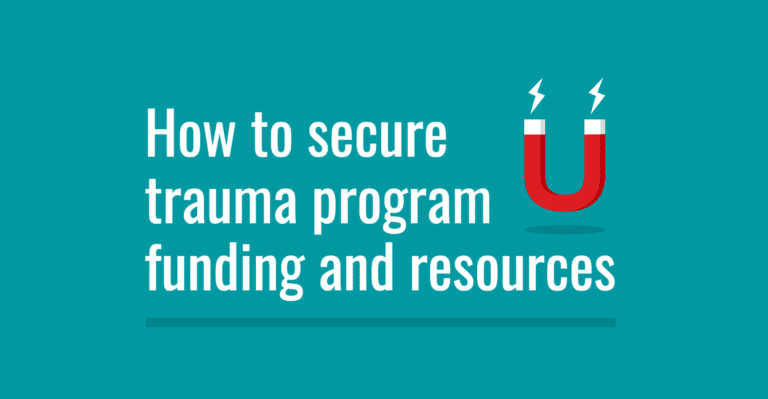Most trauma programs struggle to secure adequate funding for staff, services and equipment. On top of that, the new trauma center standards from the American College of Surgeons have introduced several requirements that may call for extra financial support. Potential new expenses include additional PI and registry staff, expanded specialty support and greater access to OR block time.

In most hospitals, these new expenses come at a bad time. Operating margins have declined sharply, and most U.S. hospitals are now operating at a loss. Hospital executives need to reduce expenses in any way possible. In this environment, requesting additional money for trauma will be a challenge.
The good news is that trauma leaders can take several actions that will transform how hospital CEOs, COOs and other executives view the trauma program.
In this article, I want to share three strategies that will help trauma program leaders shift the discussion around funding and secure the resources they need.
And on a side note — I would also like to take this moment to share three announcements that I am very excited about, including a new opportunity for trauma programs to get recognized for the value they create. (More about that at the bottom of this article.)
So what can trauma program leaders do to secure more funding and resources this year? The key is to shift the discussion from “what we need” to “what we add”.
Quantify the downstream financial value of the trauma program
When seeking additional resources from hospital administration, trauma program leaders often take a “we need” approach — We need another PI. We need physiatry coverage. We need ortho OR time.
All of these needs are important, and many of them are critical. However, when program needs constantly take center stage, trauma runs the risk of getting framed as a cost center. To increase the chances of securing new resources, program leaders must work to frame trauma as a value center.
Hospital executives have to assess many competing priorities for funding. That is why they need to understand the contribution trauma makes to the overall strategy and performance of the hospital or health system. The key for trauma program leaders is to develop a strong “we add” message.
- First, understand how the trauma “halo effect” plays out in your facility. Research has shown that the presence of a trauma program drives quality improvements throughout a hospital organization. Trauma designation also boosts a hospital’s reputation and increases EMS volume within the market. If you have not already done so, start collecting halo effect examples for your program. Some of these are anecdotal. But other instances can be linked to hard data — for instance, reductions in HAIs driven by a trauma PI corrective action plan on timely antibiotic administration.
- Second, quantify the financial benefits that flow downstream from the trauma program. Query hospital information systems to identify the surgical volume — and associated revenue — driven by patients who enter the hospital via trauma. In addition, look at the trauma program’s contribution to imaging utilization. Direct imaging revenue is just one side of the story. The trauma program’s utilization of a CT scanner also lowers the cost to operate that equipment.

Leverage trauma resources to support hospital financial goals
When a trauma program has a problem it cannot solve, the issue is typically escalated to hospital executives. This practice makes sense from a management point of view, but it colors how administration sees trauma.
While no trauma program can do away with “we have a problem” interactions, it is important to approach hospital leaders with a “we have a solution” message whenever possible. The more a trauma program delivers solutions, the more likely its requests for support will be seen in a favorable light.
For example, trauma leaders can provide essential support in specialty coverage contracting. This is a good place to start, because specialist contracting directly concerns the trauma program.
Under Standard 4.22, for instance, all Level I and II trauma centers must have continuous availability of ophthalmology. This coverage can be very expensive for a hospital, but the devil is in the details. The key is to understand that while ophthalmology coverage needs to be available, trauma programs are free to define which injuries and clinical situations require response from an ophthalmologist.
The trauma medical director and the trauma program manager should work together to define eye trauma response parameters and then use registry data to quantify expected ophthalmology utilization. Based on historical utilization, your trauma program may require only 12 to 15 ophthalmology consults per year. This data will be extremely valuable to hospital administration in negotiating a cost-effective specialty coverage contract.
As another example, say high labor costs mean your hospital lacks enough staff to ensure timely patient discharge. This is actually a key factor driving expenses in many hospitals. The trauma program can work with inpatient nursing to streamline discharge protocols for trauma patients. This will not only decrease inpatient days for trauma admissions, the learnings from this initiative could help improve discharges for all services. Even saving one day per patient will make a significant improvement in the hospital’s operating margin.
Optimize trauma’s contribution to financial performance
Trauma is a mission, not a business. Having said that, most programs can do a better job of capturing appropriate revenue from trauma cases. One solution is simply to ensure all trauma team activations (TTAs) are correctly identified in the registration system.
Getting into the weeds, the key is to make sure every TTA is registered as Field Locator (FL) 14 patient Type 5. Best practice is to automate this process within the electronic health record (EHR). For example, if your hospital uses Epic, create two simple logic fields:
- If Trauma Narrator is launched, the patient is automatically registered as Type 5
- If patient type is 5, then the only ICU revenue code available is 208
These two automations ensure that all trauma patients are correctly identified for the purpose of billing trauma activation fees and ICU daily charges. This example is for Epic, but similar automations can be set up in Cerner and other systems.

In my experience, simple steps to improve coding and charge capture will result in significant revenue improvements for trauma. The more you can improve the trauma program’s financial stewardship, the more likely you will get a sympathetic hearing from hospital executives about new financial needs.
Three announcements
As I mentioned above, I would like to take this opportunity to make three special announcements.
First, I am pleased to announce that I and my colleagues are now part of a new firm — Peregrine Health Services, LLC. While we are working under a new name and moving forward with new energy, we are the same team of clinical professionals that has been helping hospitals build stronger trauma programs and EDs for years. On behalf of everyone at Peregrine, we look forward to serving the trauma community for many years to come.
Second, the Peregrine team will continue to provide information and education that helps trauma program leaders excel. As part of that commitment, we will be hosting a new webinar next month: “How to Get Hospital Executives to Approve More Budget for Your Trauma Program”. My guests will be executive leaders from two different trauma centers who will provide practical strategies for working with the C-suite to secure financial support for the trauma program.
Third, my colleagues and I are very excited to announce the inaugural Peregrine Award for Trauma Innovation. This new award will recognize trauma teams that have developed creative solutions to challenges in trauma care and trauma program management. Entries will be judged by a national panel of trauma experts, and awards will be presented in two separate categories — one for Level I-II trauma centers and one for Level III-IV-V trauma centers.
Angie Chisolm, MBA, BSN, RN, CFRN, TCRN is managing partner at Peregrine Health Services. She is a nationally recognized expert in trauma program operational efficiency, coding and billing, site survey readiness and performance improvement. Angie is also chief operating officer and co-founder of National Quality Systems (NQS), a data management platform for trauma centers.


3 Comments
Please add me to your early notification email list. Thank you so much.
Will do. Thanks!
Pingback: How to secure trauma program funding and resources in 2023 - Peregrine Health Services